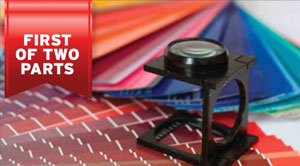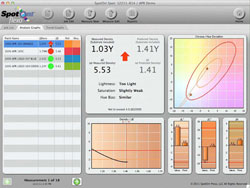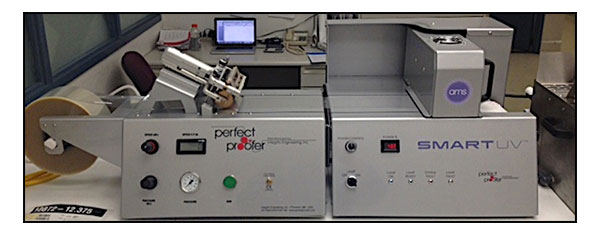
One of the alternatives related to combining enhanced quality with cost efficiency has been the application of Expanded Color Gamut (ECG) printing... 4/c process combined with RGB or OGV, depending on how one prefers to phrase it. And, it has certainly been demonstrated that, under the right conditions, this can be a very effective direction. We've seen more and more end users adopt and mandate this approach. Mark Samworth and Mark Mazur both provided very informative presentations at FFTA Forum 2013 that indicated that the use of ECG in flexible packaging may, in fact, be reaching the "tipping point".
An ECG Primer
At its' basis, the primary benefit derived from application of ECG in flexo lies in expanding the gamut through the use of additional colors. Some users have demonstrated a 40-60% increase over straight 4/c process. It's been proven that upwards of 80-90% of the Pantone formula guide can effectively be replicated with spot color simulation through the use of 7/c process. And, while that's a great benefit...it's a bit of a misconception to think that it begins and ends there. The REAL advantage to the printer in the application of 7/c ECG comes from the cost and productivity benefits...
- Reduced make ready and changeover times...even a more critical factor these days in trying to remain profitable as run lengths get shorter and shorter.
- Less ink consumption due to the capability to create recipe color simulation of spot colors with higher line count, lower volume anilox rolls
- The capability to "gang" different SKUS on the same web, leading to even greater efficiencies.
- AND the capability to create a "fixed color palette" that, when implemented all the way upstream to the design stage, creates meaningful opportunities for product uniformity and consistently meeting color expectations.
7-Color ECG
- "Gang" multiple SKUs on the same web, leading to even greater efficiencies
- Reduce makeready and changeover times, a critical factor when trying to remain profitable as run lengths are made shorter and shorter
- Create a "fixed color palette" that, when implemented throughout, affords meaningful opportunities for product uniformity and consistency in delivering color expectations
- Consume less ink due to the ability to create recipe color simulation of spot colors with higher line count, lower volume anilox rolls
Workflow tools have been developed and exist in the market today that have transformed the complexity of file preparation and color correction for 7/c process into a much more simplified and highly automated functionality. Proofing and color matching have also taken great strides in the adaption of ECG moving past the "tipping point" in flexo.
But, with all that being said and proven, the fact remains that the application of ECG isn't for everyone in flexo. The true benefits really can't be realized without volume. In conversations with several flexible packaging converters over the past couple years on this subject, the response more often than not comes back to "the whole concept makes perfect sense to me, but what I need is enough volume from one customer or enough customers willing to take the path in order to be able to dedicate one press to it and go from there." And, it is a legitimate concern. The "build it and they will come" approach can prove to be a risky proposition. True success with ECG is usually driven from the top down and requires total buy in by all players involved.
A couple of other factors that come into play are that, in flexible packaging where most of the success with ECG has been demonstrated to date, it pretty much requires a 10/c press in order to successfully implement the 7/c process approach. There's usually a white plate involved and, no matter how dedicated we are to a fixed color palette, there is still going to be the occasional brand color or special effect color that needs to be incorporated into the mix.
Cost & Benefits
With that being the case, realizing the potential benefits from printed gamut extension in flexo need not necessarily require an "all or nothing" approach. Obviously, the concept of spot color simulation through the use of 4/c process is nothing new in our world. What has historically limited true success with this approach in flexo, however, has been some of the inherent limitations associated with the process itself...reduced overall tonal range capability as a result of viscous inks, absorbent or repellant substrates and relief printing plates, in general, just to name a few.
What has changed in recent years, however, is a number of combined technological advancements that have contributed to overcoming some of these limitations in the flexo reproduction process... printing press and anilox engraving technologies, ink metering and formulations, process control features and, most notably, advances in prepress and plate technologies that have resulted in the concept of extending the gamut with four color process becoming a viable alternative for some printers.
New Look 4-Color
- Exceed SWOP standard gamut model
- Comparable results to GRACoL
- Advance screening
- Enhanced ink transfer
- Surface texturization
- Three Key Factors provide for optimizing the printable gamut with flexo:
- Higher solid ink densities
- Extended tonal range capabilities
- Improved control, consistncy and repeatability in the process
The effects of these combined technologies have resulted in three key factors that provide for optimizing the printable gamut with flexo...
- Higher solid ink densities
- Extended tonal range capabilities
- Improved control, consistency and repeatability in the process.
Whereas the ECG approach is largely about expanding the gamut through the application of additional colors, the "new look" 4/c process approach is based more on utilizing advancements in existing technologies as a path toward gamut extension.
The results of one print trial analysis utilizing some of these advanced prepress and plate technologies demonstrated that, with four color process in flexo today, we can exceed the gamut model standard for SWOP, provide comparable results to the GRACoL standard, and come close to that of even the current European Gravure standard model.
These types of results are being achieved through the application of one or more of a number of advanced prepress and plate technologies...
- Laser optics technology and higher resolution output that provides better definition and faithfully replicates more of the original gray levels
- Digital flat top dot technology that reduces or eliminates the negative effect of oxygen inhibition in the UV exposure stage
- Advanced screening technologies that further extend tonal range capability, particularly in the critical highlight zone.
- Micro surface texturization applications that lead to enhanced ink transfer and higher solid ink densities.

There are even recently developed aqueous plate formulations on the market that have proven to provide similar results without the application of digital flat top or surface texturization.
While these combined technologies provided the capability to accomplish more with four color process reproduction in flexo, that is certainly not to suggest that gamut capabilities with 4/c process can meet or exceed those of 7/c ECG. At minimum, the application of the three additional process colors will consistently provide a gamut model at a minimum of 20% larger than any 4/c process ink set.
"How Much Do You Need?"
This is the question a printer ultimately has to answer. The most effective path forward is very much situation dependent. The real value derived to the printer with either approach, however, lies in the recipe color simulation capability, leading to opportunities for "fixed color palette" creation. In committing to this path, however, comes the associated challenges of predictability, consistency and repeatability in the end result.
As the Graphics Production Manager at one of the leading consumer product companies so often states, "It doesn't matter to me if you print it offset, gravure or flexo. I don't care if you print it with four, seven or twelve colors. I don't care if you do it with magic pixie dust or standing on your head... I just want product conformity and the same results every time." While this remains as a very viable and understandable mandate, the truth remains that this objective is far easier said than done, particularly when considering that there exists, literally, hundreds of variables in the flexographic reproduction process.
While the market has dictated that printing "in control" become a top priority for nearly every flexo printer today, the stakes become much higher when committing to the path of recipe color simulation through process print. Without a road mapped and dedicated process control plan in place, a printer striving for the benefits of extended color gamut application will fail to find true success.

Preparing for ECG
So, what are the key process control components that can contribute to a successful extended gamut implementation? It certainly begins with determination of an appropriate print standard, establishing realistic tolerances to the standard and carries forward from there.
And, the establishment of "realistic" tolerances is a key point. Through either internal evaluation or customer consultation, achievable and repeatable tolerance specifications for print registration and L*a*b* Delta error must be established as a path toward accurately predicting and repeating recipe color simulation print results.
Once a standard and tolerances have been established, the path forward involves the commitment to a stringent process control plan... from prepress and proofing, through plate making and on to print reproduction. It is impossible to control what is not measured. Control targets that capture the data from all optimization, fingerprint and characterization trials must be included on "live" jobs. Real-time control charting, and comparison of the results to the average and control limits established from the fingerprint data, simplifies the process for press operators in determining when adjustments are necessary and, as importantly, when they are not necessary to maintain print quality and consistency.
Part 2 of this series will dig a little deeper into the necessary process control steps required in obtaining ongoing success in optimizing the flexo color gamut.
You can read the second part of this article here
.